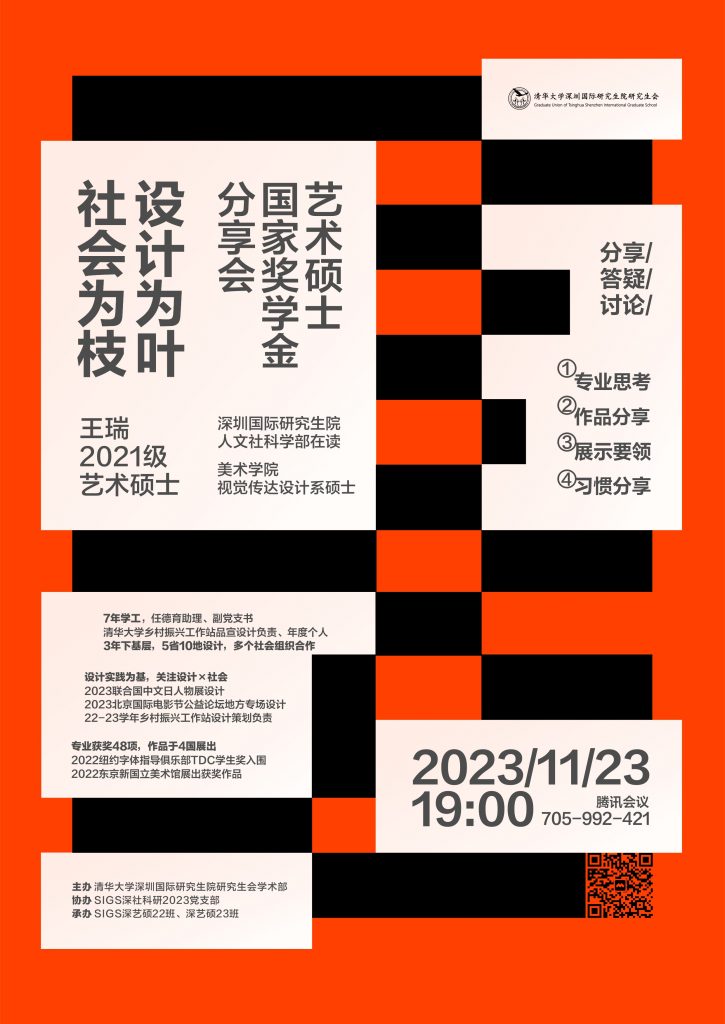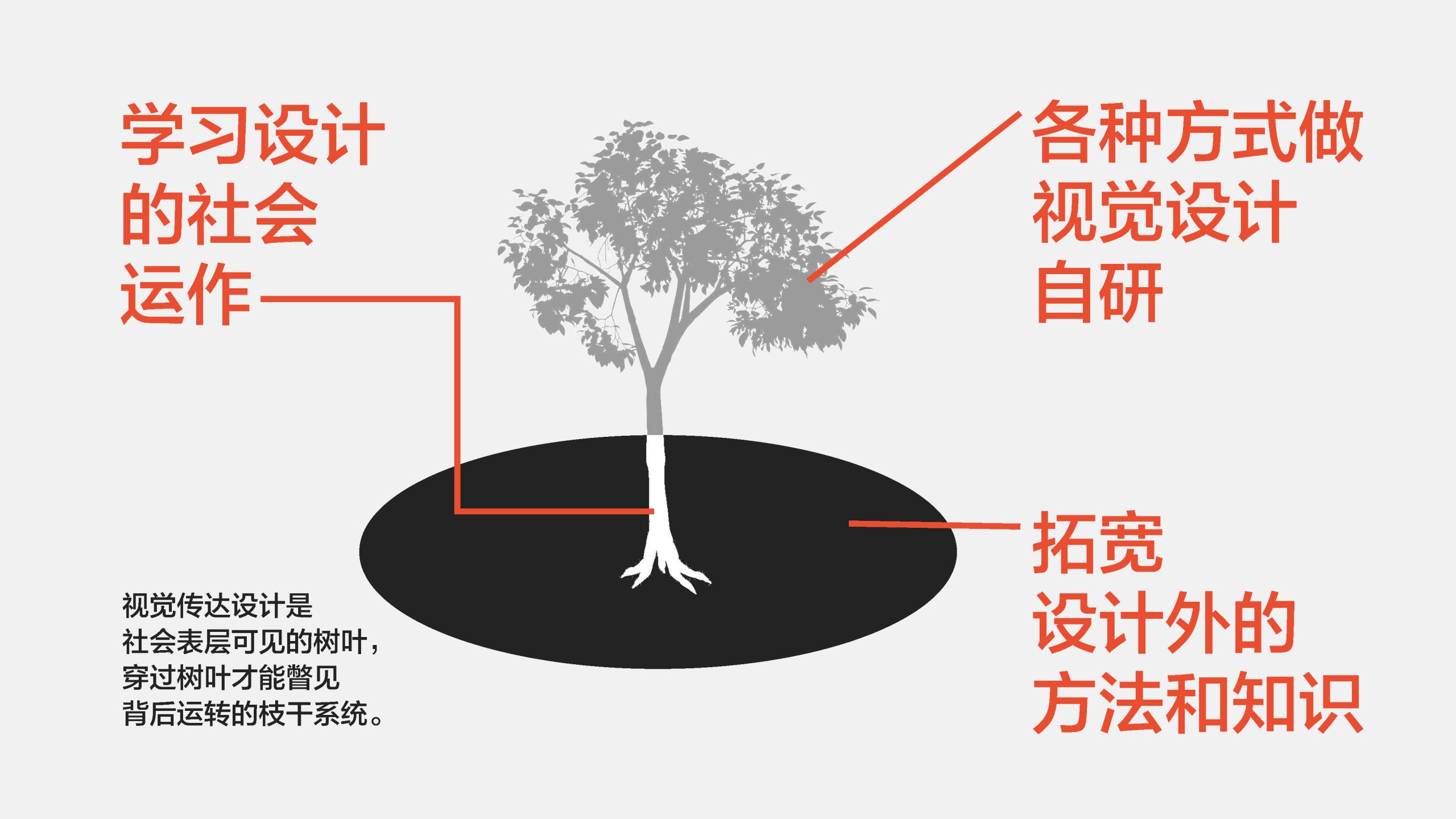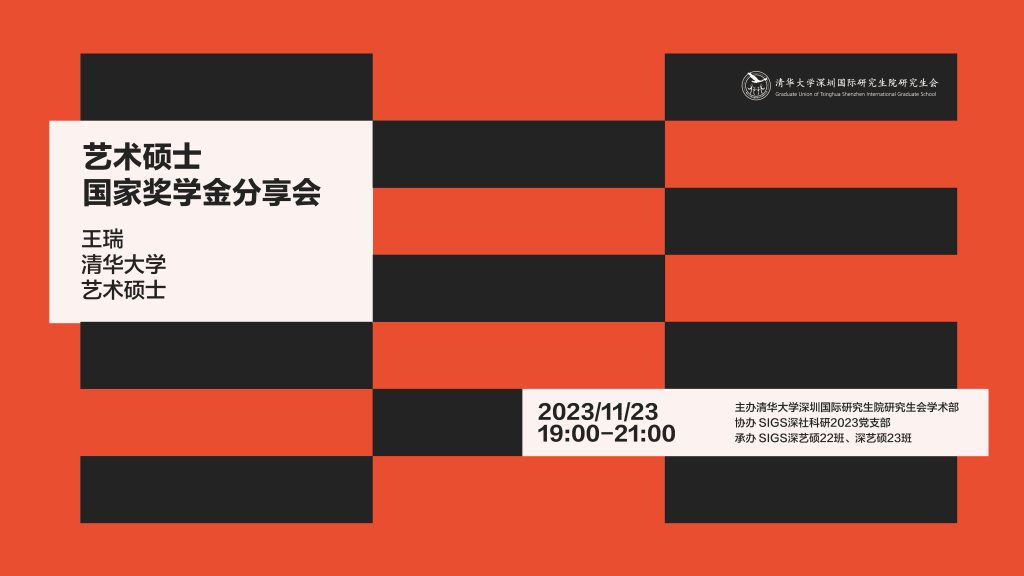SIGS研究生会学术部主办,SIGS深社科研2023党支部协办,清华大学深圳国际研究生院深艺硕22班、深艺硕23班承办的“艺术硕士国奖分享会”活动于2023年11月23日顺利举办。下是部分采访。
The MFA National Scholarship Sharing Meeting, was hosted by the Academic Department of SIGS Graduate Students’ Association, was successfully held on 23rd November 2023. This meeting invited the 2023 National Scholarship winner, Wang Rui from MFA Class 21. The following is a review。

回顾过去两年,硕士期间的设计与研究既是他个人在专业方向的多方面探索的阶段性成果,也是他在多方面探索中寻找到的一条与设计相关的“自洽”的道路。这条道路与三个方面有关。
与社会系统结合:
社会组织设计实践
入学之后,他的实践目标逐渐关注设计背后的“系统”。他自本科就关注到视觉传达设计的应用并非只是一个“求新”的过程,视觉能站在前台更是一个在后台对接、决策、交付、归档并往复的运行机制的结果。他在入学前一个月在基层实习的过程中发现,基层公共组织在设计专业化上有较大的提升空间,这次实践激励了他继续探索此方向与设计的结合。
他先后在深圳国际研究生院团委、乡村复兴论坛、乡村振兴工作站都参与了至少一年的设计工作,期间到山东、浙江等地参与短期乡村实践,负责完成了一系列涉及不同合作框架的视觉项目,一方面在不同的合作或服务模式之间积累可贵的经验,另一面对设计嵌入公共组织架构的有了更多思考。他越来越相信“视觉传达设计是社会表层可见的树叶,穿过树叶,才能瞥见背后运转的枝干系统”。
寻求平面外的视角:
跨专业设计实践
保持对视角的学习,不仅是设计过程中创作的内容,也包括对设计本身。导师在研一入学的时候发给同学们一个书单,书单里并无设计相关书籍,而是现代性研究、叙事学、文化研究、哲学类的,这些书打开了他“换个视角看世界”的门,“当我们发现周身的事物有着更深的与以往不同的观察方式时,视角的震感便来了”。
他在入学后于导师门下学习,也在课外与同学合作,硕士期间参与联合国中文日罗生特展、北京介山城市更新展等的设计,拓展了他对建筑、策展与内容研究的更多了解。与他而言,视角的世界提供了一个基于现有日常认识又不失反思价值的“新奇”。当掌握了看待世界的另一种角度,这个角度本身就超越了向他人炫耀的谈资这一层面,变成了自我内化并能与他人互通共享的“点金术”。
回到设计本身:
视觉传达设计实践
相比其他领域的学习,设计还是那块唯一的“自留地”,所以他也在专业实践中探索视觉传达设计更多的可能性。
他通过项目结合落地、竞赛获奖、理论化等多种途径打磨设计项目。例如,在社会创新设计课程中与社工协会合作的古城记忆录入-探索项目,关注的是新游客和老居民的文化弥合,获得清华大学SDG创新开放马拉松的优秀展示奖;自研的包装叙事项目,关注的是可展开一体成型包装结构与茶制作过程纹样的结合,入围红点与Pentawards的终评;小语种文字文化研究,关注的是外国文字字形的历史阶段考察,字体入围纽约TDC学生奖。此外诸如课外委托例如北影节公益论坛等项目,都有利于他探索更具有审美与创新价值的设计。
设计具有很多可能性,但对于个人发展而言,可能性又带来了一些迷茫。前期他对设计“向外探索”多建立在“我想”和“我能获得什么”的层面,后续在导师的指导下,他认识到“我有能力做什么”也是对当前阶段的重要评估标准之一。他在逐步与组织、与社会接触的过程中打磨专业本身,并借用其他专业的知识拓展对本专业的理解,是他在硕士阶段较为重要的“自洽”途径,他也获得了价值、能力与成果的多方收获。
“自洽”,也是他对学弟学妹们的期望之一,减少自我内耗,在热爱中寻找擅长的事情,且在其中真正有所收获。
Looking back on the past two years, the design and research during his master’s degree is both a milestone in his personal exploration of the various aspects of his professional direction, as well as a ‘self-referential’ path related to design that he has found in his multifaceted explorations. This path is related to three aspects:
Integrating with Social Systems:
Social Organisation Design in Practice
After entering the school, his practical goals gradually focused on the ‘system’ behind design. Since his undergraduate studies, he has learnt that the application of visual communication design is not just a process of ‘newness’, but that the ability of visualisation to be in the foreground is the result of an operational mechanism that interfaces, decides, delivers, archives and iterates in the background. During his internship at the grassroots level a month before he started his studies, he found that there is much room for improvement in the design professionalism of grassroots public organisations, which inspired him to continue exploring the combination of this direction and design.
He has been involved in design work for at least one year in the SIGSYLC, CRCV, and RRC. During this period, he participated in short-term rural practice in Shandong and Zhejiang, and was responsible for completing a series of visual projects involving different cooperation frameworks, so that he could accumulate valuable experience in different cooperation or service modes on one hand, and think more about design embedded in the structure of public organisations on the other hand. He has become more and more convinced that ‘visual communication design is the leaves visible on the surface of the society, and it is only through the leaves that we can catch a glimpse of the functioning branch system behind’.
Seeking Perspectives Beyond Design:
Interdisciplinary Design Practice
Keeping up with perspectives is not only about what is created during the design process, but also about the design itself. His mentor sent a book list to his classmates when they entered the first year of graduate school, and the list did not include design-related books, but modernity studies, narratology, cultural studies, and philosophy, which opened the door for him to ‘look at the world from a different perspective’, and ‘when we find that the things around us have a deeper way of looking at things that is different from what we used to see, the perspective is changed. When we find things around us have a deeper and different way of looking at them, the shock of perspective comes’.
He has been studying under his tutor since his admission and collaborating with his classmates outside the classroom. During his master’s degree, he participated in the design of the United Nations Chinese Language Day Exhibition, the Beijing Jieshan Exhibition, which broadened his understanding of architecture, curation, and content research. For him, the world of perspectives offers a ‘novelty’ based on the existing daily understanding without losing the value of reflection. When one masters another way of looking at the world, the perspective itself goes beyond being a talking point to show off to others and becomes a ‘golden art’ that can be internalised and shared with others.
Going Back to Design:
Visual Communication Design Practice
Compared with other fields of study, design is still the only ‘reserved area’, so he also explores more possibilities of visual communication design in his professional practice.
He polishes his design projects through various ways, such as combining projects with the ground, winning competitions and theorizing. For example, the Ancient City Memory Entry-Exploration Project, which is co-operated with the Social Workers’ Association in the Social Innovation Design Course, focuses on the cultural integration between new tourists and old residents, and was awarded the Outstanding Presentation Prize in the Innovation Open Marathon of Tsinghua University SDG. The research on the culture of small language scripts focuses on the historical stages of foreign scripts, and the typeface was shortlisted for the TDC Student Award in New York. In addition, extracurricular commissions, such as the Public Welfare Forum of the North Film Festival, have helped him to explore design with more aesthetic and innovative values.
Design has many possibilities, but for personal development, the possibilities bring some confusion. In the beginning, his ‘outward exploration’ of design was mostly based on the level of ‘what I want’ and ‘what I can get’, and then under the guidance of his mentor, he realised that under the guidance of his mentor, he realised that ‘what I am capable of doing’ is also one of the important assessment criteria for the current stage. The gradual process of engaging with organisations and society, polishing the profession itself, and expanding his understanding of the profession by borrowing knowledge from other professions is one of the more important ways of ‘self-referencing’, and he has gained multiple gains in terms of values, competencies and outcomes.
More…
‘Self-referencing’ is also one of his expectations, to reduce self-consumption, to find what they are good at in their love, and to really gain something from it.


组织
Organisers
Shenzhen International Graduate School, Academic Department of SIGS Graduate Student Union, Master Branch of Social Science 2023, MFA Class 2022 & 2023
供稿
Texts
Jin Zhao, Wang Rui
供图
Pictures
Publicity Department of Rural Revitalization Center of Tsinghua University
时间戳
Time Stamp
2023/11/23